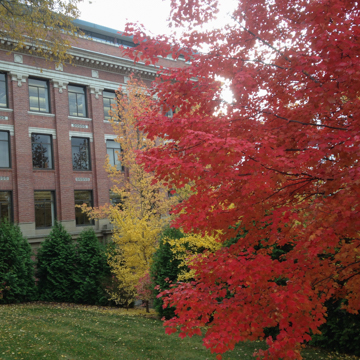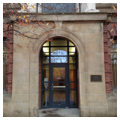You are here
Carpenter Hall
With its exterior detail looking to the Renaissance and a grand (albeit never completed) classical entrance facing towards the city of Pullman, Carpenter Hall, completed in 1926, helped to architecturally elevate the technical field of “mechanical arts” as a subject of higher learning at the state’s land grant institution. Replacing the older “Mechanical Hall” built to the east in 1893 shortly after the college was established, what was originally called the Mechanic Arts Building also helped usher in a new era of design at the college that lasted through the 1930s, where buildings more consciously revived styles popular elsewhere in the country. Situated on a promontory above Spokane Street near its intersection with College Avenue, Carpenter Hall, designed by Rudolph Weaver at a cost of $150,000, also spurred the shift of campus buildings away from the core and its original quad.
Weaver himself was partly responsible for this shift. As the first official “campus architect” (and the inaugural chair of the Architecture department, which has maintained a presence in Carpenter Hall since its inception), he designed seven buildings in the 1910s and 1920s alone, including the similarly articulated Wilson Hall (now Wilson-Short Hall) for the disciplines of Agriculture, Forestry, and Horticulture on the eastern edge of campus. Carpenter Hall and Wilson Hall (both of which began construction in 1913 but were not finished until 1926 because of restrictions during World War I) were the only two buildings of Weaver’s design that could be classified as Renaissance Revival. The others are better identified as Georgian Revival.
To help provide the design refinement for a building that originally housed the college’s “mechanical” fields, Weaver provided Carpenter Hall with a tripartite elevation on west, north, and south sides, with distinct features mimicking the base, shaft, and capital of a classical architectural order. To this end, the building originally featured rusticated sandstone marking the ground floor (or base); a three-story giant architectural order in the form of a Doric pilaster delineating floors two through four (or shaft); and a brick and terra-cotta cornice marking the roof (or capital), all covering an interior concrete structure. An original sketch shows two elaborate, twisting staircases with classical features on the west and north sides of the building, leading to entrances on the piano nobile , or second floor. Only the structure of the west-facing staircase was begun; the staircase itself was removed when Stanley Smith took over the project in 1923 and eventually replaced with a stone archway at ground level. A ground-level entrance was also built on the north side.
Although the materials and overall articulation were rather different, Weaver’s treatment of three of the Carpenter Hall facades could be traced to Michelangelo’s design for the buildings assembled around Rome’s Campidoglio, where three-part facade divisions, marble, and a sculptural staircase helped redefine a previously dilapidated part of the city and announced a new image for the eternal city. While Weaver was not faced with similar political challenges at Washington State College and only a handful of campus buildings followed its lead, Carpenter Hall’s design, as well as its elevated position above the city, makes for a possible analogy. The steep slope on Carpenter Hall’s western side, however, as well as its physical distance from downtown, may have made a staircase on the order of Michelangelo’s cordonata practically impossible.
Weaver’s twelve-year tenure at Washington State College was crucial considering the trajectory of his career, which included the founding of two architecture programs (one at the University of Idaho in 1923 and then another at the University of Florida in 1925). Beyond his architectural contributions at the college, his instructional methods, which combined traditional design (based upon fine drafting skills) and a working knowledge of the business of architecture with the basic principles of construction, ensured that students would not forsake the pragmatics of building for exquisite design—and vice versa. In many ways, Weaver’s teaching philosophy could be understood in relation to his design for Carpenter Hall as well as President Bryan’s vision for the university, which was to elevate the practical fields into the realm of higher learning. In 1949, the Mechanic Arts Building was renamed in honor of H.V. Carpenter, the first dean of the College of Mechanic Arts and Engineering. In 1960, an elevator was added to the building.
In the early 1990s, Carpenter Hall underwent an extensive interior renovation process, carried out by the Seattle-based firm of Naramore, Bain, Brady and Johanson (NBBJ) during the height of a stylistic architectural postmodernism. The project was under the principal design direction of Dorman Anderson, a graduate of the Architectural Engineering program and former university instructor from the late 1960s and early 1970s. NBBJ retained the building’s basic interior configuration of broad corridors linking open studios on the north and south wings on floors two through four, although little else was retained. Abstractions of classical features such as broken pediments and column capitals were added to support structures in public spaces on the first floor and to offices and a conference room on an entirely new fifth floor.
To alleviate the dead load of the fifth-floor addition, contractors laid a corrugated steel deck with lightweight concrete fill, replacing the existing concrete deck on the fourth-floor roof. The fifth floor itself was installed as a steel frame structure. In an attempt to highlight the historic character of the building when viewed from the exterior, NBBJ set the fifth floor slightly back from the fourth-floor parapet. From inside, the parapet compromises views from the offices and conference room.
The original terra-cotta cornice above the fourth floor has been replaced with a fiberglass cornice of identical design and the partially built baroque staircase intended to lead to the second-floor entrance on the west facade was long ago removed in favor of ground-level entrances at the west, south, and north sides. Yet the original sandstone classical entrance still hovers about the first floor on the west facade, and—with the exception of the fifth-floor addition—for the most part the entire exterior retains its original condition.
Writing Credits
If SAH Archipedia has been useful to you, please consider supporting it.
SAH Archipedia tells the story of the United States through its buildings, landscapes, and cities. This freely available resource empowers the public with authoritative knowledge that deepens their understanding and appreciation of the built environment. But the Society of Architectural Historians, which created SAH Archipedia with University of Virginia Press, needs your support to maintain the high-caliber research, writing, photography, cartography, editing, design, and programming that make SAH Archipedia a trusted online resource available to all who value the history of place, heritage tourism, and learning.





















